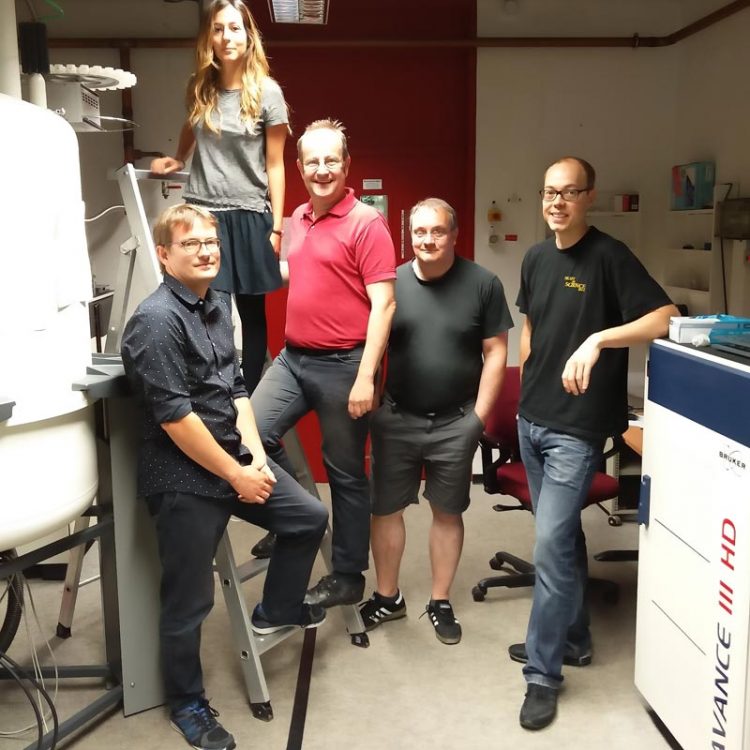Pause to read the traffic sign: regulation of DNA transcription in bacteria

The participating researchers Dr. Boris Fürtig (from the left), Sara Keyhani, Prof. Harald Schwalbe, Prof. Dr. Jens Wöhnert and Dr. Florian Sochor in front of one of the spectrometers with which the measurements were made. (Photo: Daniel Hymon)
One of the central tenets of biology is that information flows from DNA to RNA in order to encode proteins, which function in the cell. Arguably just as critical as the genetic code is the timing of this information flow. By producing the right RNA and right proteins at the right time, a cell can effectively strategize its survival and success.
One such regulatory element, the riboswitch, has excited interest as a potential target for antibiotics. After over 10 years of research, Prof. Harald Schwalbe's research group at the Goethe University, in collaboration with the Landick group at the University of Wisconsin, Prof. Jens Wöhnert from Goethe-University’s Biology Department and the Süß group at the Technische Universität Darmstadt, has put together the puzzle pieces of a riboswitch-based regulatory process in the bacterium Bacillus subtilis, presenting the most extensive model of the timing of riboswitch action to date.
A riboswitch is a short piece of RNA that can fold into different structures, depending on whether or not a small messenger molecule is binds to it. In transcriptional riboswitches, these different structures signal the nearby RNA polymerase to continue producing RNA or to stop.
In their recent publication in ELife, the Schwalbe group and their collaborators released molecular structures of the xpt-pbuX riboswitch in the off-position after synthesis and in the on-position upon binding by the small messenger molecule guanine. They also demonstrated that this switch to the on-position takes a certain amount of time. This sets a certain requirement on this regulatory process.
As RNA polymerase flies along a DNA strand, producing the corresponding RNA, it reaches the code for the xpt-pbuX switch, makes the riboswitch, and continues on. If guanine is not around, the RNA polymerase would detect the default off-position and halt synthesis. However, if guanine were to bind the riboswitch, the riboswitch would need to refold into the on-position, and RNA polymerase would have to wait long enough to detect the new conformation.
Otherwise, it would always read “off”, and that gene would never be read. Schwalbe and coworkers found that just such a pause does exist, and it's encoded into the DNA. After producing the xpt-pbuX switch, the RNA polymerase encounters this “pause site” on the DNA code and slows down, allowing the right amount of time for the riboswitch to refold.
This work provides the most in-depth kinetic model of riboswitch function to date and underscores the importance of pause sites in our understanding of riboswitches. As researchers consider using riboswitches as tools in synthetic biology applications, they will do well do keep the speed of the RNA polymerase in mind.
Publication: Steinert H, Sochor F, Wacker A, Buck J, Helmling C, Hiller F, Keyhani S, Noeske J, Grimm S, Rudolph MM, Keller H, Mooney RA, Landick R, Suess B, Fürtig B, Wöhnert J, Schwalbe H.; Pausing guides RNA folding to populate transiently stable RNA structures for riboswitch-based transcription regulation.; Elife; 2017; doi: 10.7554/eLife.21297.
Further Information: Prof. Dr. Harald Schwabe, Institute for Organic Chemistry, email: schwalbe@nmr.uni-frankfurt.de
Media Contact
More Information:
http://www.uni-frankfurt.deAll latest news from the category: Life Sciences and Chemistry
Articles and reports from the Life Sciences and chemistry area deal with applied and basic research into modern biology, chemistry and human medicine.
Valuable information can be found on a range of life sciences fields including bacteriology, biochemistry, bionics, bioinformatics, biophysics, biotechnology, genetics, geobotany, human biology, marine biology, microbiology, molecular biology, cellular biology, zoology, bioinorganic chemistry, microchemistry and environmental chemistry.
Newest articles

Trotting robots reveal emergence of animal gait transitions
A four-legged robot trained with machine learning by EPFL researchers has learned to avoid falls by spontaneously switching between walking, trotting, and pronking – a milestone for roboticists as well…

Innovation promises to prevent power pole-top fires
Engineers in Australia have found a new way to make power-pole insulators resistant to fire and electrical sparking, promising to prevent dangerous pole-top fires and reduce blackouts. Pole-top fires pose…

Possible alternative to antibiotics produced by bacteria
Antibacterial substance from staphylococci discovered with new mechanism of action against natural competitors. Many bacteria produce substances to gain an advantage over competitors in their highly competitive natural environment. Researchers…





















